By way of background, “Ancient Egypt” is comprised of three kingdoms, the Old Kingdom (2686 BC – 2134 BC), Middle Kingdom (2050 BC – 1650 BC), and New Kingdom (1500 – 1069 BC), with an Intermediate Period after each Kingdom. For context, the pyramids of Saqqara and Giza were all built during the Old Kingdom. Before moving out of the Old Kingdom, I want to comment on the thing that interests me most in Giza: the Great Sphinx. The commonly accepted (and promoted) story about the age and origin of the Sphinx is that it was carved by Khafre, the builder of the second tallest pyramid at Giza, who lived between 2600 and 2500 BC. But there are two things that make some question this. First, the Sphinx shows erosion that is consistent with that caused by heavy rains, and it hasn’t rained heavily in Egypt since before 5000 BC, which is 2,500 years before the pyramids of Giza were built. Second, the Sphinx’s head is that of a pharaoh (most say the head is an image of Khafre), on a body of a lion. That’s fine, but it is obvious that the head has been recarved because the proportions are all wrong — the head is too small for the body — and proportions are just not something the ancient Egyptians got wrong. So, some believe the Sphinx was carved earlier than the pyramids and then the head was recarved by Khafre (and our highly knowledgeable guide in Luxor agreed), but when or by whom, no one can even guess.
 Apparently the entire surface of the temples was painted. Paint still survives today in some temples; this is a ceiling in Medinet Habu temple with a pillar (totally carved with a lot of paint yet) in the upper left.
Apparently the entire surface of the temples was painted. Paint still survives today in some temples; this is a ceiling in Medinet Habu temple with a pillar (totally carved with a lot of paint yet) in the upper left.
LUXOR
When we had seen everything we wanted to see in the Cairo area, we traveled forward through ancient time and moved up the Nile to Luxor, which was known then as Thebes. This is where the famed tombs of the Valleys of the Kings, Queens and Nobles are located, as well as incredible cult temples and funerary temples, most everything dating from the New Kingdom. It was here that Howard Carter discovered King Tut’s intact tomb in 1922, and it is here that ancient Egypt truly comes alive for me. In fact, it was here 10 years ago that, thanks to one amazing guide, I decided I’d love to be an Egyptologist. Someday? Well, only if I don’t have to actually go into pyramids…
The ancient Egyptians believed that this life was to be spent preparing for the real deal, the afterlife. This is why a lot of the things that survive center around death, and most of the rest center around their gods. The pyramids were monuments to dead pharaohs, who are believed to have been buried in them. In the New Kingdom, they weren’t building pyramids anymore; the pharaohs were buried in the Valley of the Kings, their queens in the Valley of the Queens, and high ranking individuals in the Valley of the Nobles. All of the tombs are underground and were dug into solid rock; some are large with many hallways and chambers. The walls and ceilings are literally covered in art, most of which is for the purpose of instructing the dead on how to go safely to the afterlife. Although every tomb we saw was unique and amazing, our very favorite tombs were in the Valley of the Nobles, and Queen Nefertari’s tomb in the Valley of the Queens. Nefertari was the favorite queen of the powerful and long lived Ramses II, whose many temples and statues are everywhere. Her tomb is said to be the most beautiful tomb in Egypt, and we can’t argue with that. It was spectacular. As opposed to King Tut’s tomb, which isn’t very impressive, this one is worth the extra cost to see.
The Tombs of the Nobles are quite different (and arguably more interesting) than those in the Valleys of the Kings and Queens. The royal tombs only contain scenes of the dead pharaoh and/or queen and the gods, whereas the nobles’ tombs also depict the daily life of those buried there, or what they were responsible for. For example, one tomb is painted with grape vines and other foods the Egyptians ate because that nobleman was responsible for the harvest. Photos are not allowed in any of the tombs, so we only have a few (bad ones) that we snuck with our cell phones.
 From a tomb of a noble — they are harvesting grapes and making wine in the top two right images (among doing other things related to the harvest).
From a tomb of a noble — they are harvesting grapes and making wine in the top two right images (among doing other things related to the harvest).
 The colors aren’t right here, but this is from Nefertari’s tomb. So is the first photo at the very top of this post.
The colors aren’t right here, but this is from Nefertari’s tomb. So is the first photo at the very top of this post.
Besides the tombs, Luxor has several incredible funerary temples of the pharaohs and temples to the gods. One funerary temple that stands out from the rest is Hatshepsut’s, the only female pharaoh. It has clean lines and is so modern looking that it could have been built today; it was probably Peter’s favorite sight in Egypt. On the east side of the Nile, there are two major temples to the gods (Luxor Temple and Karnak Temple) that used to be connected by the Avenue of the Sphinxes, which was a road, three kilometers long, lined on both sides by thousands of human headed sphinxes. Dozens still stand today near Luxor Temple, and the entire Avenue is currently being excavated. The plan is to once again connect the great temples, which would be pretty incredible. As a tip, most sights in Egypt must be seen in the heat of the day, but Luxor Temple is open and lit up at night, and I think it’s pretty magical to see it that way.
 Hatshepsut’s magnificient funerary temple at Deir el Bahari.
Hatshepsut’s magnificient funerary temple at Deir el Bahari.
 Taken from the Avenue of the Sphinxes looking at Luxor Temple. (Click to see the full size and more detail)
Taken from the Avenue of the Sphinxes looking at Luxor Temple. (Click to see the full size and more detail)
For something different and equally interesting, we also visited Deir-el-Medina, which is the well preserved village where the workers and artisans who created the tombs in the Valley of the Kings lived. For insurance purposes, these workers were kept isolated from everyone else. They weren’t allowed to leave the village except to go to work because they knew where the pharaohs’ tombs were and what treasures were going to be buried there. On their days off, these artists spent their time working on their own tombs in the area, and because these were some of the top artisans of the day, their tombs are modest but beautifully painted.
 Deir-el-Medina, the walled village with only one gate where people could enter and exit, which was guarded 24×7.
Deir-el-Medina, the walled village with only one gate where people could enter and exit, which was guarded 24×7.
Before leaving Luxor, we also did a few day trips outside of town, namely to see the temples at Dendara and Abydos, both of which were worthwhile if you have the time and a deeper interest in Egyptian history. Then from here, we went further south to Aswan.
Here are a few more photos of Luxor, and then the post continues below:
ASWAN
If you’re an Agatha Christie fan, you may have heard of Aswan. It was the setting of Death on the Nile, where Dame Agatha had spent time with her archaeologist husband. Aswan is close to the southern border of Egypt, in what was Nubia in ancient times. The Nile is at its most picturesque here. Huge black granite boulders jut out from it, and Nubian villages are located on islands in the middle of it and on the west bank, where we stayed.
 The Nile, standing on the west bank looking north.
The Nile, standing on the west bank looking north.
The granite that is so present in the ancient statues, temples and obelisks to the north came from here. How these enormous, incredibly heavy stones were moved is one of the remaining mysteries of ancient Egypt. For context, one of Hatshepsut’s obelisks that was erected in Luxor was made of a single piece of Aswan pink granite that was 94 feet tall and weighed 343 tons. We went to the ancient pink granite quarry where this mammoth stone came from, and saw an even bigger unfinished obelisk, which would have been the largest ancient obelisk ever completed (that is known), commissioned by none other than Hatshepsut. While it was being carved in place in the quarry, it developed a crack, so it was never finished and left in place, which has provided archaeologists with a lot of information on how these obelisks were carved. It would have been 137 feet tall and weighed nearly 1,200 tons. Twelve hundred tons! And they were going to move that rock from the quarry to the Nile where it would be put on a wooden boat held together by ropes and floated up the river to Luxor, about 150 miles away, then set it in place somewhere, all done only with human power because they had no domesticated animals like horses to help. Doing that today is very hard to imagine; doing it back then is mind boggling and has caused several people to speculate that there were techniques known by the Egyptians that have been lost over time. I think there must have been.
One of the main draws of going all the way up the Nile to Aswan is to see the temples of Abu Simbel, which was not only a marvel of its time, but also a marvel of modern times because the temples were moved — piece by piece — to higher ground before they built a high dam in Aswan, which would have put them under water. Agatha Christie even writes about Abu Simbel in her book. Ten years ago I went to Egypt with my mom, and she got ridiculously sick after eating some fresh parsley and derailed our trip by spending three days in bed in Cairo. As a result, she and I didn’t make it to Aswan, so I really wanted to see Abu Simbel on this trip. Unfortunately, once Peter and got there, we were a bit traveled-out and sighted-out, and the thought of getting up at 4:00 a.m. to join a caravan to make the 4-hour drive to Abu Simbel, only to have to drive back the same day, was more than we could get ourselves to do. Someday!
From our room, I watched these camels go home at the end of their day:

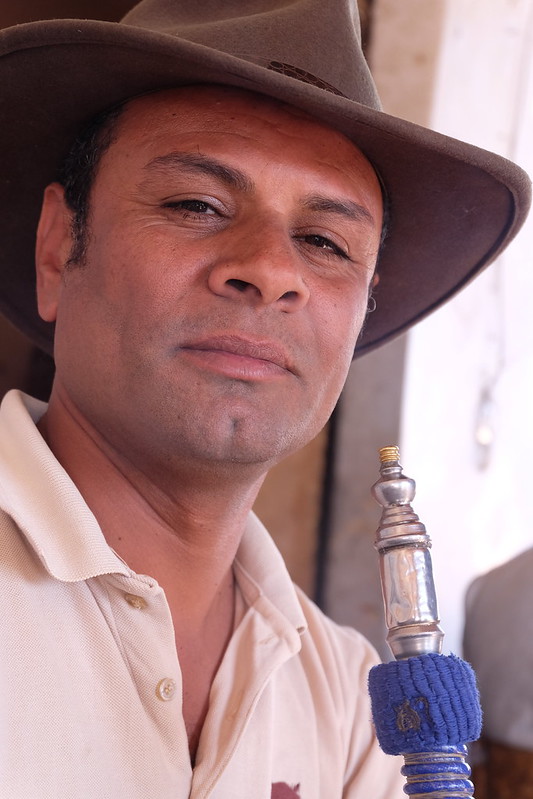










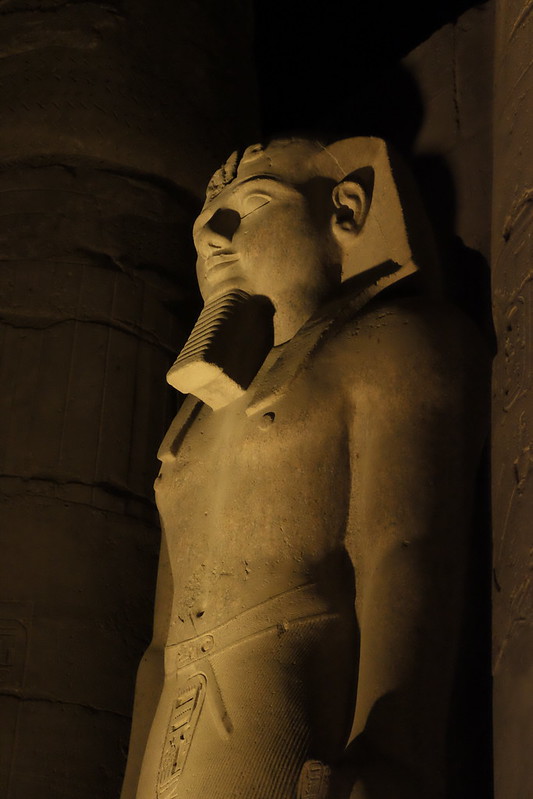



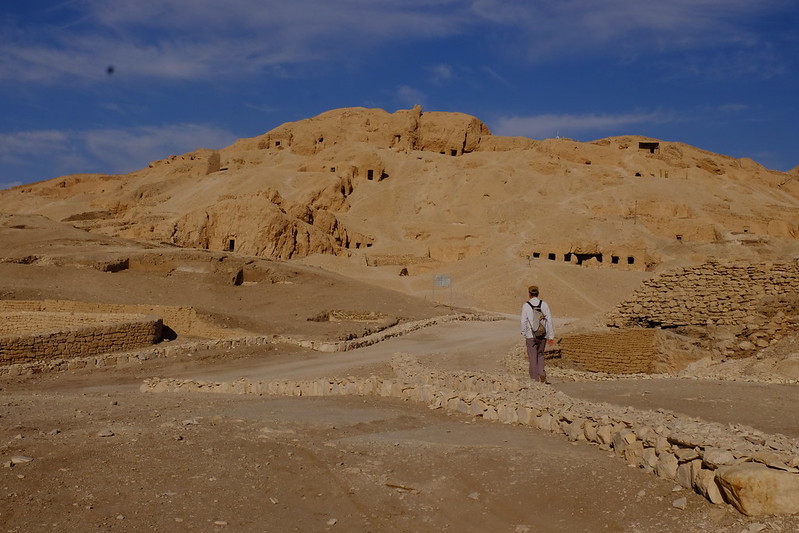




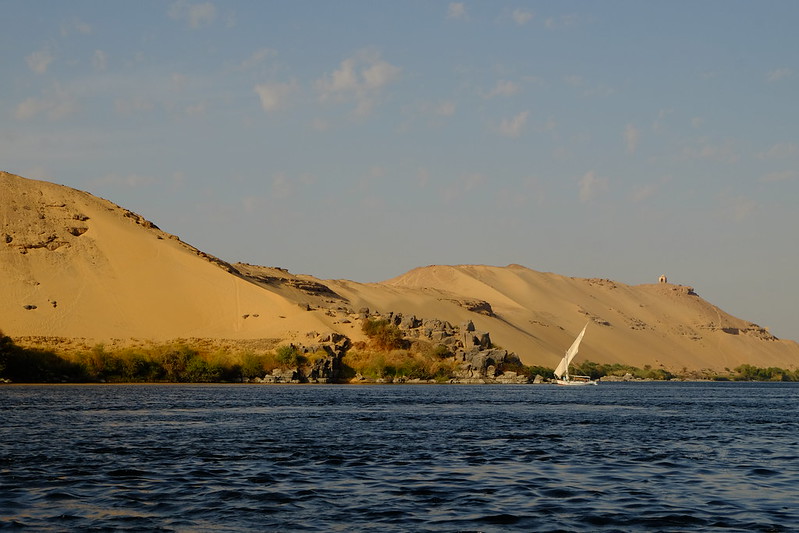


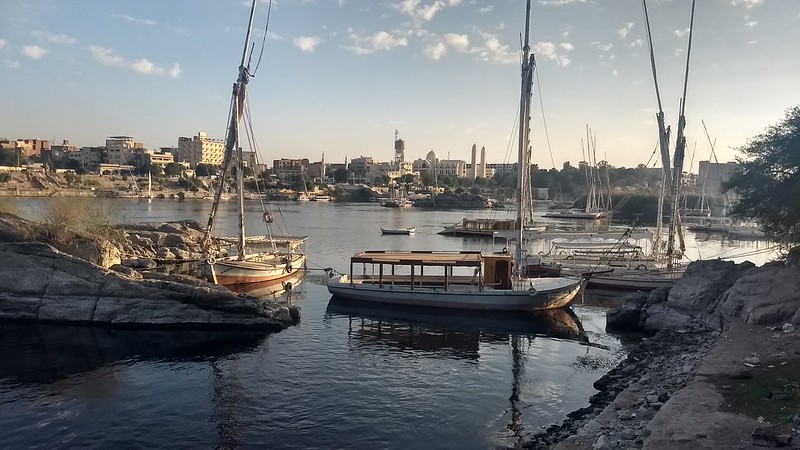

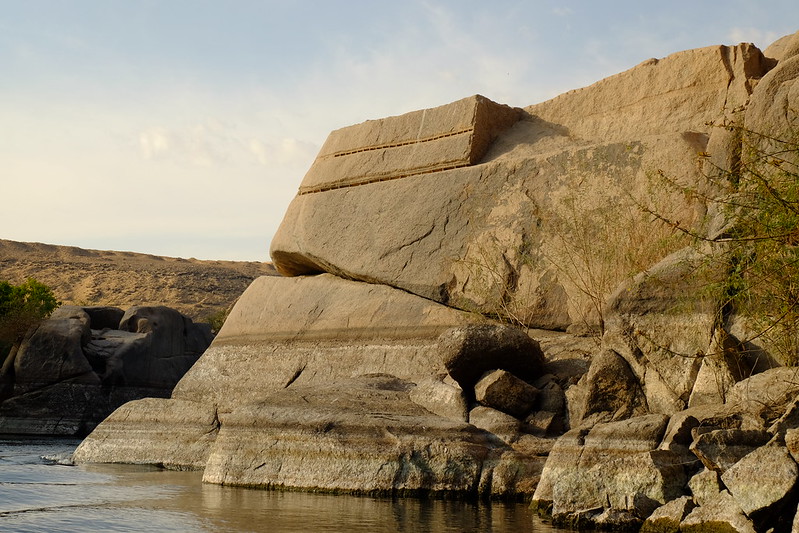








4 replies